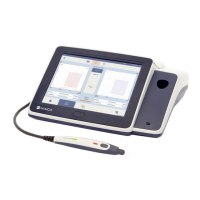Operation Manual
touchTymp MI 24
and
MI 34
Version
1.5.3 Printing Options
Printing test results from the touchTymp are accomplished in a variety of ways:
Use the build-in printer to directly print results.
Transfer touchTymp test data into the PC-software and print results on your PC-printer.
1.6 Description
1.6.1 General
The touchTymp is designed for Immittance testing as Tympanometry and Acoustic
Reflex (i.e. Ipsilateral and Contralateral) testing ( and MI 34 version).
MI 34 version also includes Reflex Decay and Eustachian Tube Function (ETF) tests.
The functions are described in detail in the following sections.
1.6.2 Tympanometry
Tympanometry is the objective measurement of middle ear mobility (compliance
)
and pressure
within the middle ear system (Figure 1). During the test, a low-pitched
probe tone (226 Hz) is presented to the ear canal by means of the hand-held probe.
This tone is used to measure the change in compliance in the middle ear system while
the air pressure is varied automatically from a positive value (i.e. +200 daPa) to a
negative value (i.e. -400 daPa max).
Maximum compliance of the middle ear system occurs, when the pressure in the
middle ear cavity is equal to the pressure in the external auditory canal. This is the
highest peak of the curve as it is recorded on the chart. The position of the peak on the
horizontal axis and on the vertical axis of the chart will provide diagnostic information
regarding the function of the middle ear system. Gradient calculations are reported as
the Tympanogram width at half of peak compliance expressed in daPa. A normative
box is available on both the display and printout to aid in diagnosis.
NOTE: 1 mmho ≙ 1 ml for 226 Hz probe tone
Compliance is measured with respect to an equivalent volume of air, with the scientific quantity milliliter (ml).
Air pressure is measured in deca-Pascals (daPa).

